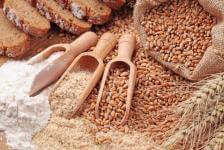Grains, Phytic Acid, and Dairy: An Update
Many people claim that soaking grains in yogurt or buttermilk increases mineral absorption. But new research casts doubts on this assertion. Find out what you need to know about soaking grains to break down phytic acid.

Q. Monica, thanks for being the voice of reason in nutrition. In your tip from August 2009, you suggested soaking uncooked oats in yogurt or buttermilk to reduce phytic acid. But is it OK to eat the yogurt? I stir raw oats and nuts into Greek yogurt and let it sit for an hour or so before eating–not because of the phytic acid, just because I like it this way. But I have had low B12 reading[s] at my last two check-ups and now I’m wondering whether it’s the raw oatmeal. Do I need to soak it longer or should I eat something else?
Answer. I’m so glad you wrote with this question because it gives me an opportunity to update my previous advice in light of new information. As I talked about in the episode you mention, phytic acid is a compound found in raw grains and nuts that can interfere with the absorption of certain nutrients.
Just for the record, I don’t think that most people really need to worry about this. As I wrote back in 2009, “Mineral deficiencies caused by too much phytic acid in the diet are mostly a concern in developing countries where diets tend to be nutritionally deficient or borderline.”

Friends, it turns out that this may not have been good advice.
While it’s true that lactobacillus bacteria and acidic mediums both help break down phytic acid, it turns out that calcium can block the enzymatic breakdown of phytic acid. If reducing phytic acid is your goal, soaking your grains in plain water may be a better bet.
See also: How to Get More Nutrients From Grains
Now that I’ve gotten that off my chest, I still need to answer my listener’s questions! First, when you soak grains in liquids to reduce phytic acid, the phytic acid is broken down enzymatically, so it’s perfectly OK to consume the liquid. Second, although soaking grains for just an hour will have some effect, soaking them for 12-24 hours will a much more complete job of breaking down phytic acid.
And lastly–and perhaps most importantly–the phytic acid in your raw oatmeal is almost certainly not responsible for your low B12 levels because phytic acid does not interfere with the absorption of this nutrient. Fortunately, it sounds as if your doctor is paying attention and can suggest appropriate steps to track down the cause (and cure) for this situation.






